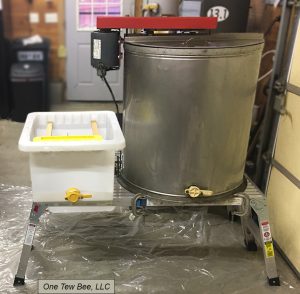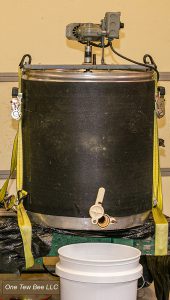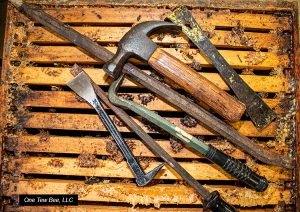Click Here if you listened. We’re trying to gauge interest so only one question is required; however, there is a spot for feedback!
Read along below!
 A Few Unique Beekeeping Tools
A Few Unique Beekeeping Tools
And some other cockamamie ideas
By: James E. Tew
I’ve done this all my beekeeping life
One of my very first beekeeping thoughts when I was first accidentally introduced to beekeeping was, “I can build this wooden equipment.” So, I did. As a totally new beekeeper with above average woodworking abilities, I set up the shop, bought pine lumber, built jigs for making repetitive cuts and went to work. For a couple of years, I even built my own wooden frames. While I was never cost competitive, I got a strange satisfaction from cutting my wooden equipment (Of the hundreds and hundreds of frames, boxes, lids and inner covers that I built, not a single one remains. Not one. I wish I had just one of the pieces that I built. At the time, it was not important. Bummer.). It was my beekeeping project and not something I just bought. I loved doing this work… until I didn’t.
After only about two seasons, the simple construction procedures and the mindlessly repetitive cuts became monotonous. When running power woodworking tools, boredom is a great way to be awarded a trip to the emergency room. In my life, I have made two of those trips, but I am happy to say that I still have all my body parts. I have not built my own equipment for many years now. I still could, but why bother. Been there – done that.
All my beekeeping life, I have looked at non-beekeeping devices and various procedures and wondered, “Could I use that in my beekeeping efforts?” I’m not talking about things like a woodworking shop, a pickup truck, a mobile phone or a good pair of boots. Rather, I am talking about odd items that were never intended for beekeeping use that could possibly be effectively used in my beekeeping craft. Be forewarned readers that much of what follows is half-baked. Only a few recommendations will be made. As it were, “do not try this at home.”
An electric heat gun
I am amazed at how often a heat gun fulfills an unanticipated use, both in life and in beekeeping, but in this article, I want to stay within beekeeping. I have used heat guns to soften heavily propolized frame rests in bee boxes. Quickly heating the gummy propolis makes it significantly easier to scrape and clean. I have used heat guns to quickly liquify small amounts of honey when I was in a rush. I have used heat guns to loosen the sticky bottom bearing in my old extractor. I have used heat guns to clean and sterilize my hive tool. On the web, some of you have described how to use a heat gun to uncap honey. The uses seem endless. But then I became too excited. Could I use this heating device in the beeyard?
So, I set the heat to a level low, and opened a hive and hit the alerted bees with a waft of very warm air. It did not have the desired effect. In fact, it may have even energized the bees a bit. I quickly decided that the idea was one for the beekeeping idea trash heap. I rolled up the extension cord and put the gun away.
But wait. I just saw in an advertisement, that major heat gun manufacturers are producing battery-powered units. No extension cord would be required. Obviously, I will be needing one of those.
This is my tentative plan. Next Spring, I want to see if I can use the hot air produced by the battery-powered heat gun to soften the propolis seal on the inner cover when I want to gently open a colony. Secondly, I want to see if I can use the battery unit to soften propolis on the top bars to loosen them without having to pry and bang them from the bottom side. While it looks good on paper, I’ll have to get back to you next Spring. Stand by.
Ratchet straps
Ratchet straps are essentially complicated Bungee Cords™. While both are beautiful devices, the ratchet strap is now a significant part of my beekeeping equipment and is listed in some supply catalogs.
Of course, as I have told you time and again, I am no longer a young man. In my youth, when preparing to move hives, the best recommendation that I had was hive staples or the early non-ratcheting version of straps. The non-ratcheting straps were too difficult to tighten and loosened too easily. They failed the test. Staples were a different story. During those times, beekeepers bought staples by the case. There were even instructions on how and where to position the staples on the hive bodies.
An aside…
Many years ago, Trucker’s Hitches were a style of rope knots that were used to tie down bee colonies (and anything else that one wanted to keep from falling from a wagon or a trailer). This tiedown system is even older than staples. Today, video instructions for tying this simple knot are readily available on the web. I have personally used ropes with Trucker’s Hitches to lash eighty colonies for a round trip from Ohio to Florida. This old idea, that greatly predates ratchet straps, is still useful – but rarely used – today.
Installing staples was somewhat comical. Nothing alerted the bees like banging on the sides of the hives as the staples were being installed. Envision this scenario. So, there we were – preparing to move colonies and banging on the colonies to get them agitated before loading them. Then, more banging on the hive when the staples were removed. Staples were not a perfect plan, but at the time, the procedure was the best we had – grumpy bees or not (My Dad took a typically novel beekeeper approach to securing hive parts. He used brick-ties and attached to hive boxes with dry wall screws for securing hives when moving to watermelon
pollination. He used a battery-powered drill to drive the screws. Brick-ties are reasonably cheap and can be used time and again. Just another beekeeper idea.).
An aside…
Hive staples are a historic bee supply catalog sleeper. While I can’t say when they were first offered in bee supply catalogs, I can find them in catalogs in 1931, but not in 1928 catalogs. For sure hive staples have been used in beekeeping for ninety-two consecutive years. In the earliest years, staples were copper coated so they could be used multiple times without rusting. It should be noted that, over time, re-occurring staple use caused considerable damage to wooden hive bodies.
Yet, another staple aside…
Hive staples have been handy for uses other than beekeeping. I have used them to improvise a gate-closing mechanism. They work well as hanging hooks. I have used them for quickly joining two boards together. For the improvisational person, these large staples can provide quick, clever solutions to immediate problems. They can also puncture tires when dropped in the bee yard.

Figure 1. A ratchet strapped hive ready for moving. I had broken the propolis seal, so I also used Dad’s brick straps.
I don’t remember the first time I was introduced to the ratchet strap. Now, I must have twenty of them. I use these common tools for multiple things, but I particularly use them for moving colonies. I always buy the heavy duty, narrow straps.
For heavy colonies being loaded under rough conditions, I ratchet strap the hive components together with a single strap, and then I ratchet strap the whole hive to the hand truck I am using. Propolis is useful in restricting the slippage of the strapped hive components.
They work best if the ratcheting mechanism is in the center of the hive top. Locating the ratcheting mechanism along the side is second best. Letting the hooks hang along the side while the strapping mechanism is still on the top is least desirable. The only quirk? Threading the strap into the ratchet mechanism has a bit of learning curve. You will figure it out. These gadgets are field tested and proven.
The limitation to ratchet straps is the sheer number required for moving large numbers of colonies. They become impractical. These devices would seem best suited for hobby keepers or at best, smaller sideline beekeepers.
Foldable work platforms

Figure 2. A collapsible work platform used as an extractor stand. Later, to provide a wider platform, another stand was added.
I use two foldable work platforms as a support base for my extractor and settling tank. The platforms tolerate “some” wobble and are stout enough to withstand the weight. Initially, I tried a single platform, but it was too unstable. For a larger working surface, I ratchet strap two platforms together. While not perfect, it is a quick and simple procedure. This is yet another beekeeping item I found at a home supply company.
Snow mats
Beekeepers in warm climates will be at a disadvantage here. For those of you who never see snow, it’s premature to rush out and buy several of these things. Stand by. For those who deal with snow, heated mats seem to cry to be used in beekeeping.
I wrap my extractor tank with these large heating mats. It helps keep the tank barrel warm so that the honey flows to the bottom faster. I was reluctant to put the heating mat beneath the vibrating, wobbling extractor. I was afraid that it would wear through the mats and cause an electrical short circuit.

Figure 3. A heated snow mat and ratchet straps for securing the extractor.
I tried putting the mats beneath a large, heavy aluminum flat pan to see if I could use the mats to heat honey supers before extracting. That didn’t work. Primarily, the problem seemed to be that the mats did not produce enough heat.
But what would happen if I put heating mats beneath my wintering hives? I have no idea how that would work, but I continue to be intrigued by my lingering idea. The mats are about two feet wide and about five feet long. There is enough length to have two colonies sit on one mat. This is one of those ideas that works well on paper. Maybe one Winter day I will give it a shot.
An aside…
I emailed the manufacturer of the snow mats and told them I was exploring using their mats in my honey extracting operation and how I was using them. The company did not respond. Later, in response to an advertisement for their snow mats, I sent an iMessage again describing my interest. They did not respond to that message either. Two messages with no response. Don’t you think that should tell me something?
Moisture Meter
I have a moisture meter for determining the water content of wood that I am working with. Of course, I immediately wondered if I could simply put the moisture meter probes in honey and get a moisture reading from the meter. Didn’t work. I contacted the company and they sent a different detecting connector, but I could not make that work either. The scale was not sensitive enough.
Beekeepers, that would be so slick if it would work. Rather than having to load and clean a refractometer, I would only need to put the probes in the honey and – voila – a moisture reading. I have backed away from this use for my wood moisture meter use. Someone else can give it a try.
Pry bars
In my experience with beekeeping, hive tools have come a long way, but still not far enough. If a beekeeper is working a smallish hive that is regularly worked, all is well when using the traditional hive tool. However, when trying to dig out frames from a behemoth colony that has not been opened in a long while, the light hive tools are pushed to the maximum. I have an assortment of larger pry bars – to include a wrecking bar. None were purchased from a bee supply catalog. But be aware that there is an upper limit. When using pry bars with significant leverage, the soundly stuck top bar will rip from the end bars rather than pull the frame out.

Figure 4. Some of my non-beekeeping heavy duty hive tools. The blue one in the lower left is my favorite.
Propolis-embedded plastic frames are miserable to pull out with any type of hive tool. The plastic flexes allowing the pry bar to break free. Those frames will require being driven out from the bottom of the super. I have a modified short-handled hammer that I use for that purpose. Plus, I can still use the hammer to drive nails and staples.
I’m out of space
There is seemingly no end to this rambling thread, but I must stop.
- I presently use HVAC pads as leveling foundations beneath some of my hives.
- I have wondered if an old, retired sleep apnea air compressor device could be used to deliver smoke or oxalic acid fumes to my colonies.
- A leaf blower can clearly be used to remove bees from supers, but is there some way that it could also be used to deliver smoke to a colony?
- Can the flame from a propane-powered weed killer be used to sterilize wooden equipment or to melt away burr combs and propolis? One day, I will try this device for these purposes.
- I have successfully used a pet bowl heater for providing a Winter water supply for my bees. Wintering birds also greatly appreciated this rare water supply.
- I use a three inch wide scraper with a disposable blade for removing old combs from foundation inserts. I found the scraper at a big box home supply store. Ironically, I use my heat gun to soften the combs before scraping.
- Would a deer cart be more (or less) useful than a typical hand truck for moving a bee hive? I don’t know.
- Could the plastic bags that my newspaper comes in be used as a disposable syrup feeder bag for wintering colonies? I don’t see why not. Presently, I have about one hundred of these bags crying for some bee use.
- Does a mylar survival blanket have any use for the wintering bee colony – especially when used inside the hive. I’m still thinking.
- Archery equipment has been used to string a retrieval line to a high swarm. While I have not personally done this, others of you have. You know who you are. You sent me photos.
What have you done?
Beekeepers are an adaptive lot. If you have novel uses for tools or devices that you would want to share with others, let me hear from you. Clearly, I love cockamamie gadgetry.
Thank you
I appreciate the time you take to read my articles. I enjoy hearing from you. Thank you.
Dr. James E. Tew
Emeritus Faculty, Entomology
The Ohio State University
tewbee2@gmail.com
 Co-Host, Honey Bee
Co-Host, Honey Bee
Obscura Podcast
www.honeybeeobscura.com








